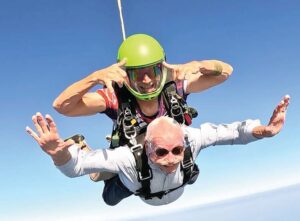
Jay Bender skydives in tandem with instructor Brian Martins. Photo courtesy of Skydive Carolina in Chester
Jay Bender and his twin brother, Ray, were born in Oklahoma in 1944. The family moved to New Mexico soon after. Jay still visits the Land of Enchantment regularly and Ray, a retired Army officer, lives in San Diego.
Jay jumped out of a perfectly good airplane for the first time in 1963, while stationed at Fort Rucker, Alabama. He was a private assigned to Fort Rucker’s aircraft maintenance school. His only excuse was there wasn’t much to do recreationally in Lower Alabama. As a native Alabamian, I can heartily agree with that reasoning.
A member of skydiving clubs at Fort Rucker, Fort Lee, Virginia, and West Point, along with a civilian club in Albuquerque, New Mexico, Jay made 50 jumps between 1963 and 1966, when he followed Coach Paul Dietzel from West Point to Columbia.
“In the Army planes were available at no charge. Civilians pay to jump and as a college student I couldn’t afford to jump any longer,” he says.
Bender has been practicing law in Columbia since 1975. He earned a journalism undergraduate degree from the University of South Carolina in 1970, and a law degree from there five years later.
“I was also a fulltime faculty member in both schools between 2006 and 2016,” Bender said.
Bender’s law career has largely focused on media issues, which has earned him a national reputation. He has been legal counsel for the South Carolina Press Association and newspapers, for over 40 years. He also represented the Catawba Indian Nation in the settlement of a land claim that arose in 1840. He is regarded as South Carolina’s foremost authority on the South Carolina Freedom of Information Act.
Bender replaced the expensive habit of skydiving with riding motorcycles.
He says, “I have never regarded jumping out of airplanes as a sign of insanity. Skydiving is enjoyed around the world. I raced motorcycles and rode motorcycles on very long routes and always thought that was much more dangerous than skydiving.”
He rode various two wheelers from Key West, Florida, to Prudhoe Bay, Alaska, and later to the Four Corners of the United States—Key West, Florida; San Ysidro, California; Blaine, Washington; and Madawaska, Maine. In his spare leisure time, Bender also enjoyed whitewater kayaking, running marathons, and climbing Mt. Rainier, Mt. Fuji, and most of Mt. Kilimanjaro.
After retiring, Bender began painting, a more seemly pastime for octogenarians. But skydiving never appeared on his No Longer Possible list.
“The parachutes used today are far superior to the military surplus chutes we used in the ’60s. I was interested in jumping with one of the new model parachutes to experience how much more maneuverable they are than the ones I used in the Army,” Bender says. “Last year my children, grandchildren, and great-grandchildren joined my wife and me for a celebration of my 80th birthday.”
There was a skydiving operation not far from where the Bender clan gathered in eastern Tennessee. Bender floated the idea of a tandem jump to celebrate his birthday and to try out the new model parachute.
A tandem jump differs from the jumps Bender had made previously. The jump is under the control of a guide with the passenger strapped in front. One son, a daughter, a son-in-law, and a grandson signed up for tandem jumps. Unfortunately thunderstorms over three days prohibited jumping. So the to-do list still included skydiving with the new parachute. Here’s how that item was checked off.
“I went to Skydive Carolina in Chester for the jump,” Bender said. “The weather was perfect. The plane got us to altitude quickly and a roll-up door made for an easy exit. Having a guide in control was the only difference from solo jumping. The exit from the plane and the freefall were familiar. The new parachute lived up to my expectations. It could be driven all over the sky in comparison to the round canopies we used in my first jumps.”
A highlight of Bender’s day was meeting a woman who had been on the Army’s Golden Knights skydiving team.
“When I asked her how many thousand jumps she had, her reply was ‘22.’ Having a person with her experience jumping at the facility was a great endorsement,” Bender said. “The facilities were superb; the staff was efficient and friendly. Brian Martins, the guide jumper was competent and professional and the videographer was accomplished.”
When asked if there would be more skydiving, Bender replied, “Not likely. As I commented to the guide and the videographer, I am much less limber in 2025 than I was in 1966. Moving around the plane was far easier when I was in my 20s than now that I’m in my 80s.”
For more information about tandem jumping, visit www.skydivecarolina.com.
To watch Jay’s tandem jump, visit freefall.ing/j/ipupx7a8?s=e


Loading Comments